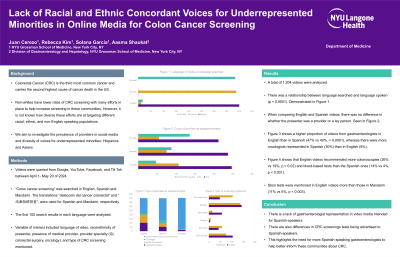Monday Poster Session
Category: Colorectal Cancer Prevention
P2108 - Lack of Racial and Ethnic Concordant Voices for Underrepresented Minorities in Online Media for Colon Cancer Screening
Monday, October 28, 2024
10:30 AM - 4:00 PM ET
Location: Exhibit Hall E

Has Audio

Juan Cerezo, MD
NYU Grossman School of Medicine
New York, NY
Presenting Author(s)
Juan Cerezo, MD1, Rebecca kim, MD1, Solana Garcia, 1, Aasma Shaukat, MD, MPH2
1NYU Grossman School of Medicine, New York, NY; 2NYU Langone Health, New York, NY
Introduction: Colorectal Cancer (CRC) is the third most common cancer and carries the second highest cause of cancer death in the US. Non-whites have lower rates of CRC screening. With the advent of social media, many patients use information obtained from social media to make decisions about their health. However, it can be difficult to navigate online spaces with the large amount of health-related information available. It is also not known how diverse these efforts are at targeting different racial, ethnic, and non-English speaking populations. We aim to investigate the prevalence of providers in social media and diversity of voices for underrepresented minorities: Hispanics and Asians.
Methods: Videos were queried from Google, YouTube, Facebook, and Tik Tok between April 1- May 20 of 2024. “Colon cancer screening” was searched in English, Spanish and Mandarin. The translations “detección del cancer colorectal” and “结直肠癌筛查”, were used for Spanish and Mandarin, respectively. We reviewed the first 100 search results in each language. Variables of interest included language of video, race/ethnicity of presenter, presence of medical provider, provider specialty (GI, colorectal surgery, oncology), and type of CRC screening mentioned. Statistical analysis was performed using Chi-Square and Z-test.
Results: A total of 1,204 videos were analyzed. There was a relationship between language searched and language spoken (p < 0.0001). When comparing English and Spanish videos, there was no difference in whether the presenter was a provider or a lay person. When comparing specialties represented, we found there was a higher proportion of videos from gastroenterologists in English than in Spanish (47% vs 40%, < 0.0001), whereas there were more oncologists represented in Spanish (30%) than in English (9%). For screening tests mentioned, English videos recommended more colonoscopies (26% vs 19%, p < 0.02) and blood-based tests than the Spanish ones (14% vs 4%, p < 0.001). Stool tests were mentioned in English videos more than those in Mandarin (11% vs 5%, p < 0.003).
Discussion: We found that despite being a majority English-speaking country, there is language concordant information present on social media. However, there is a lack of gastroenterologist representation in video media intended for Spanish-speakers. There are also differences in CRC screenings tests being advertised to non-English speakers. This highlights the need for more Spanish-speaking gastroenterologists to help better-inform these communities.
Disclosures:
Juan Cerezo, MD1, Rebecca kim, MD1, Solana Garcia, 1, Aasma Shaukat, MD, MPH2. P2108 - Lack of Racial and Ethnic Concordant Voices for Underrepresented Minorities in Online Media for Colon Cancer Screening, ACG 2024 Annual Scientific Meeting Abstracts. Philadelphia, PA: American College of Gastroenterology.
1NYU Grossman School of Medicine, New York, NY; 2NYU Langone Health, New York, NY
Introduction: Colorectal Cancer (CRC) is the third most common cancer and carries the second highest cause of cancer death in the US. Non-whites have lower rates of CRC screening. With the advent of social media, many patients use information obtained from social media to make decisions about their health. However, it can be difficult to navigate online spaces with the large amount of health-related information available. It is also not known how diverse these efforts are at targeting different racial, ethnic, and non-English speaking populations. We aim to investigate the prevalence of providers in social media and diversity of voices for underrepresented minorities: Hispanics and Asians.
Methods: Videos were queried from Google, YouTube, Facebook, and Tik Tok between April 1- May 20 of 2024. “Colon cancer screening” was searched in English, Spanish and Mandarin. The translations “detección del cancer colorectal” and “结直肠癌筛查”, were used for Spanish and Mandarin, respectively. We reviewed the first 100 search results in each language. Variables of interest included language of video, race/ethnicity of presenter, presence of medical provider, provider specialty (GI, colorectal surgery, oncology), and type of CRC screening mentioned. Statistical analysis was performed using Chi-Square and Z-test.
Results: A total of 1,204 videos were analyzed. There was a relationship between language searched and language spoken (p < 0.0001). When comparing English and Spanish videos, there was no difference in whether the presenter was a provider or a lay person. When comparing specialties represented, we found there was a higher proportion of videos from gastroenterologists in English than in Spanish (47% vs 40%, < 0.0001), whereas there were more oncologists represented in Spanish (30%) than in English (9%). For screening tests mentioned, English videos recommended more colonoscopies (26% vs 19%, p < 0.02) and blood-based tests than the Spanish ones (14% vs 4%, p < 0.001). Stool tests were mentioned in English videos more than those in Mandarin (11% vs 5%, p < 0.003).
Discussion: We found that despite being a majority English-speaking country, there is language concordant information present on social media. However, there is a lack of gastroenterologist representation in video media intended for Spanish-speakers. There are also differences in CRC screenings tests being advertised to non-English speakers. This highlights the need for more Spanish-speaking gastroenterologists to help better-inform these communities.
Disclosures:
Juan Cerezo indicated no relevant financial relationships.
Rebecca kim indicated no relevant financial relationships.
Solana Garcia indicated no relevant financial relationships.
Aasma Shaukat: iterative health; Freenome – Consultant.
Juan Cerezo, MD1, Rebecca kim, MD1, Solana Garcia, 1, Aasma Shaukat, MD, MPH2. P2108 - Lack of Racial and Ethnic Concordant Voices for Underrepresented Minorities in Online Media for Colon Cancer Screening, ACG 2024 Annual Scientific Meeting Abstracts. Philadelphia, PA: American College of Gastroenterology.
